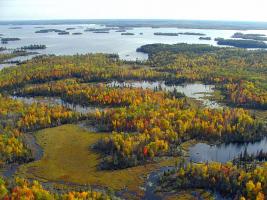Chemicals that cause endocrine system disruption in aquatic animals were found in Kabetogama Lake, one of the lakes that makes up Voyageurs National Park, according to a recent study.

The joint study by the U.S. Geological Survey, St. Cloud State University, and the Minnesota Pollution Control Agency discovered endocrine disrupting chemicals in all 11 lakes it surveyed across Minnesota. Most of the lakes also had fish showing signs of feminization due to the chemicals. The lakes represented a range of trophic conditions and watershed land uses, and did not include lakes where wastewater treatment plants discharged water.
The U.S. Geological Survey’s media release on the study is HERE.
“We were surprised to see the same types of compounds found in wastewater treatment plant discharges in these Minnesota lakes,” USGS scientist Jeffrey Writer said. “This study illustrates a need for future research to learn more about where these chemicals are coming from and the potential effects on the fish.”
The study sampled lake water and lake sediment for endocrine disrupting chemicals. It also sampled resident fish and caged fish introduced to the lakes for 21 days, some of which showed feminization in that time. Although endocrine disrupting chemicals and endocrine disruption in both resident fish and caged minnows were generally more pronounced in lakes surrounded by urban and agricultural lands, they were also identified in more remote lakes, like Kabetogama.
An abstract of the study can be found HERE.
The study is part of an ongoing program looking at the water quality of lakes in Minnesota. More information can be found at the USGS Emerging Contaminant and Endocrine Studies in Minnesota web site, HERE.
You can listen to an audio interview about the study with the USGS’s Writer, HERE.

